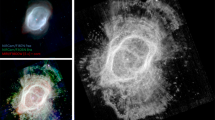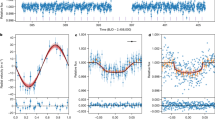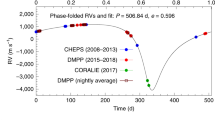Abstract
Planetary nebulae are the ionized ejected envelopes surrounding the remnant cores of dying stars. Theory predicts that main-sequence stars of one to about eight solar masses may eventually form planetary nebulae. Until now, this has not been confirmed at the higher end of the mass range. Here we report that the planetary nebula BMP J1613-5406 is associated with the Galactic star cluster NGC 6067. Stars evolving off the main sequence of this cluster have a mass of around five solar masses. Our confidence in the association between the planetary nebula and the cluster comes from their tightly consistent radial velocities in a sightline with a steep velocity–distance gradient, common distances, and reddening and location of the planetary nebula within the cluster boundary. This is an unprecedented example of a planetary nebula whose progenitor star mass approaches the theoretical lower limit of core-collapse supernova formation. This finding provides observational evidence supporting theoretical predictions that stars of five solar masses and more can form planetary nebulae.
This is a preview of subscription content, access via your institution
Access options
Access Nature and 54 other Nature Portfolio journals
Get Nature+, our best-value online-access subscription
$29.99 / 30 days
cancel any time
Subscribe to this journal
Receive 12 digital issues and online access to articles
$119.00 per year
only $9.92 per issue
Buy this article
- Purchase on Springer Link
- Instant access to full article PDF
Prices may be subject to local taxes which are calculated during checkout




Similar content being viewed by others
Data availability
Our XSHOOTER data can be accessed from the ESO Science Archive Spectral Data Products (http://archive.eso.org/wdb/wdb/adp/phase3_spectral/form). The data that support the plots within this paper and other findings of this study are available from the corresponding author upon reasonable request.
SHS data can be accessed from: http://www-wfau.roe.ac.uk/sss/halpha/.
VPHAS + data can be found at: http://www.vphasplus.org/.
References
Iben, I. Jr. Planetary nebulae and their central stars—origin and evolution. Phys. Rep. 250, 2–94 (1995).
Maciel, W. J., Costa, R. D. D., Dopita, M. & Sutherland, R. in Planetary Nebulae: Their Evolution and Role in the Universe Vol. 209 (ed. Kwok, S.) 551 (Astronomical Society of the Pacific, 2003).
De Marco, O. The origin and shaping of planetary nebulae: putting the binary hypothesis to the test. Publ. Astron. Soc. Pac. 121, 316 (2009).
Dopita, M. A. & Meatheringham, S. J. The evolutionary sequence of planetary nebulae. Astrophys. J. 357, 140–148 (1990).
Collaboration, G. et al. The Gaia mission. Astron. Astrophys. 595, 1–36 (2016).
Karakas, A. I. & Lugaro, M. Stellar yields from metal-rich asymptotic giant branch models. Astrophys. J. 825, 22 (2016).
Miller Bertolami, M. M. New models for the evolution of post-asymptotic giant branch stars and central stars of planetary nebulae. Astron. Astrophys. 588, 1–21 (2016).
Cummings, J. D., Kalirai, J. S., Tremblay, P.-E., Ramirez-Ruiz, E. & Choi, J. The white dwarf initial–final mass relation for progenitor stars from 0.85 to 7.5M ⊙. Astrophys. J. 866, 1–14 (2018).
Jacoby, G. H., Morse, J. A., Fullton, L. K., Kwitter, K. B. & Henry, R. B. C. Planetary nebulae in the globular cluster PAL 6 and NGC 6441. Astron. J. 114, 2611 (1997).
Parker, Q. A. et al. PHR 1315-6555: a bipolar planetary nebula in the compact Hyades-age open cluster ESO 96-SC04. Mon. Not. R. Astron. Soc. 413, 1835–1844 (2011).
Parker, Q. A. et al. The AAO/UKST SuperCOSMOS Hα survey. Mon. Not. R. Astron. Soc. 362, 689–710 (2005).
Parker, Q. A., Bojičić, I. S. & Frew, D. J. HASH: the Hong Kong/AAO/Strasbourg Hα planetary nebula database. J. Phys. Conf. Ser. 728, 032008 (2016).
Frew, D. J., Bojičić, I. S. & Parker, Q. A. A catalogue of integrated Hα fluxes for 1258 Galactic planetary nebulae. Mon. Not. R. Astron. Soc. 431, 2–26 (2013).
Frew, D. J. et al. Flux calibration of the AAO/UKST SuperCOSMOS Hα Survey. Mon. Not. R. Astron. Soc. 440, 1080–1094 (2014).
Majaess, D. et al. Anchors for the cosmic distance scale: the Cepheid QZ Normae in the open cluster NGC 6067. Astrophys. Space Sci. 347, 61–70 (2013).
Moni Bidin, C. et al. Investigating potential planetary nebula/cluster pairs. Astron. Astrophys. 561, 1–14 (2014).
Alonso-Santiago, J. et al. NGC 6067: a young and massive open cluster with high metallicity. Mon. Not. R. Astron. Soc. 469, 1330–1353 (2017).
Mermilliod, J. C. Comparative studies of young open clusters. III—Empirical isochronous curves and the zero age main sequence. Astron. Astrophys. 97, 235–244 (1981).
Silaj, J., Jones, C. E., Sigut, T. A. A. & Tycner, C. The Hα profiles of Be shell stars. Astrophys. J. 795, 1–12 (2014).
Girardi, L., Bressan, A., Bertelli, G. & Chiosi, C. Evolutionary tracks and isochrones for low- and intermediate-mass stars: from 0.15 to 7 M ⊙, and from Z = 0.0004 to 0.03. Astron. Astrophys. Suppl. Ser. 141, 371–383 (2000).
Bressan, A. et al. PARSEC: stellar tracks and isochrones with the PAdova and TRieste Stellar Evolution Code. Mon. Not. R. Astron. Soc. 427, 127–145 (2012).
Marigo, P. et al. A new generation of PARSEC-COLIBRI stellar isochrones including the TP-AGB phase. Astrophys. J. 835, 1–19 (2017).
Mathieu, R. D. in Stellar Clusters and Associations: Convection, Rotation, and Dynamos Vol. 198 (eds Pallavicini, R., Micela, G. & Sciortino, S.) 517 (Astronomical Society of the Pacific, 2000).
Frew, D. J., Parker, Q. A. & Bojičić, I. S. The Hα surface brightness-radius relation: a robust statistical distance indicator for planetary nebulae. Mon. Not. R. Astron. Soc. 455, 1459–1488 (2016).
Savage, B. D. & Mathis, J. S. Observed properties of interstellar dust. Annu. Rev. Astron. Astrophys. 17, 73–111 (1979).
Wesson, R., Stock, D. J. & Scicluna, P. Understanding and reducing statistical uncertainties in nebular abundance determinations. Mon. Not. R. Astron. Soc. 422, 3516–3526 (2012).
Chu, Y.-H., Kwitter, K. B., Kaler, J. B. & Jacoby, G. H. The relation between radius and expansion velocity in planetary nebulae. Publ. Astron. Soc. Pac. 96, 598–602 (1984).
Maciel, W. J., Costa, R. D. D. & Idiart, T. E. P. Age distribution of the central stars of Galactic disk planetary nebulae. Astron. Astrophys. 512, 1–7 (2010).
Pottasch, S. R. Local space density and formation rate of planetary nebulae. Astron. Astrophys. 307, 561–578 (1996).
Reid, W. A. & Parker, Q. A. An evaluation of the excitation-class parameter for the central stars of planetary nebulae. Publ. Astron. Soc. Aust. 27, 187–198 (2010).
Kaler, J. B. & Jacoby, G. H. Central star temperatures of optically thick planetary nebulae and a distance-independent test of dredge-up theory. Astrophys. J. 345, 871–880 (1989).
Weston, S., Napiwotzki, R. & Sale, S. Central stars of planetary nebulae in SDSS and IPHAS. J. Phys. Conf. Ser. 172, 012033 (2009).
Miszalski, B. et al. MASH-II: more planetary nebulae from the AAO/UKST Hα survey. Mon. Not. R. Astron. Soc. 384, 525–534 (2008).
Drew, J. E. et al. The VST photometric Hα survey of the southern Galactic plane and bulge (VPHAS+). Mon. Not. R. Astron. Soc. 440, 2036–2058 (2014).
Stetson, P. B. DAOPHOT—a computer program for crowded-field stellar photometry. Publ. Astron. Soc. Pac. 99, 191–222 (1987).
Barker, H. et al. The binary fraction of planetary nebula central stars—III. The promise of VPHAS+. Mon. Not. R. Astron. Soc. 475, 4504–4523 (2018).
Conti, P. S. & Alschuler, W. R. Spectroscopic studies of O-type stars. I. Classification and absolute magnitudes. Astrophys. J. 170, 325 (1971).
Peimbert, M. & Torres-Peimbert, S. in Planetary Nebulae Vol. 103 (ed. Flower, D. R.) 233−241 (D. Reidel, 1983).
Karakas, A. I. Updated stellar yields from asymptotic giant branch models. Mon. Not. R. Astron. Soc. 403, 1413–1425 (2010).
Moreno-Ibáñez, M., Villaver, E., Shaw, R. A. & Stanghellini, L. Compact planetary nebulae in the Galactic disk: analysis of the central stars. Astron. Astrophys. 593, 1–11 (2016).
Fragkou, V., Parker, Q. A., Zijlstra, A., Shaw, R. & Lykou, F. The central star of planetary nebula PHR 1315 - 6555 and its host Galactic open cluster AL 1. Mon. Not. R. Astron. Soc. 484, 3078–3092 (2019).
AAO Software Team 2dfdr: Data Reduction Software 2015ascl.soft05015A (Astrophysics Source Code Library, 2015); https://www.aao.gov.au/science/software/2dfdr
Modigliani, A.et al. in Observatory Operations: Strategies, Processes and Systems III Vol. 7737 (eds Silva, D. R., Peck, A. B. & Soifer, B. T.) 1–12 (SPIE, 2010).
Crawford, S. M. et al. in Ground-based and Airborne Instrumentation for Astronomy III Vol. 7735 (eds McLean, I. S., Ramsay, S. K. & Takami, H.) 1–7 (SPIE, 2016).
Netopil, M., Paunzen, E., Heiter, U. & Soubiran, C. On the metallicity of open clusters. III. Homogenised sample. Astron. Astrophys. 585, 1–17 (2016).
Kharchenko, N. V., Piskunov, A. E., Schilbach, E., Röser, S. & Scholz, R.-D. Global survey of star clusters in the Milky Way. II. The catalogue of basic parameters. Astron. Astrophys. 558, 1–8 (2013).
Turner, D. G. The PL calibration for Milky Way Cepheids and its implications for the distance scale. Astrophys. Space Sci. 326, 219–231 (2010).
Mermilliod, J. C., Mayor, M. & Udry, S. Red giants in open clusters. XIV. Mean radial velocities for 1309 stars and 166 open clusters. Astron. Astrophys. 485, 303–314 (2008).
Piskunov, A. E., Schilbach, E., Kharchenko, N. V., Röser, S. & Scholz, R.-D. Tidal radii and masses of open clusters. Astron. Astrophys. 477, 165–172 (2008).
An, D., Terndrup, D. M. & Pinsonneault, M. H. The distances to open clusters from main-sequence fitting. IV. Galactic Cepheids, the LMC, and the local distance scale. Astrophys. J. 671, 1640–1668 (2007).
Mermilliod, J. C., Mayor, M. & Burki, G. Membership of Cepheids and red giants in 8 open clusters—NGC 129, 6067, 6087, 6649, 6664, IC 4725, LY 6, RU 79. Astron. Astrophys. Suppl. Ser. 70, 389–407 (1987).
Coulson, I. M. & Caldwell, J. A. R. The Cepheid HD 144972 and the problematic distance to the open cluster NGC 6067. Mon. Not. R. Astron. Soc. 216, 671–678 (1985).
Walker, A. & Coulson, I. M. CCD photometry of galactic clusters containing Cepheid variables. Paper 3: Photometry and identification charts for NGC 6067. South Afr. Astron. Obs. Circ. 9, 97–110 (1985).
Walker, A. R. CCD photometry of galactic clusters containing Cepheid variables. II—NGC 6067. Mon. Not. R. Astron. Soc. 214, 45–53 (1985).
Mermilliod, J. C. Comparative studies of young open clusters. Part 2. An atlas of composite colour-magnitude diagrams. Astron. Astrophys. Suppl. Ser. 44, 467 (1981).
Thackeray, A. D., Wesselink, A. J. & Harding, G. A. The cluster NGC 6067. Mon. Not. R. Astron. Soc. 124, 445 (1962).
Trumpler, R. J. Preliminary results on the distances, dimensions and space distribution of open star clusters. Lick Obs. Bull. 14, 154–188 (1930).
Acknowledgements
Part of this work is from data obtained from the ESO Science Archive Facility under request number 336270. Some reported observations were obtained with the SALT. Q.A.P. and V.F. thank the University of Hong Kong (HKU) for travel support for the SALT observations and the Hong Kong Research Grants Council for General Research Fund (GRF) research support under grants 17326116 and 17300417. V.F. thanks HKU for her PhD scholarship. We thank D. Frew for input to the XSHOOTER proposal and for early project work (we have been unable to get a reply from him to agree to the co-authorship that he deserves).
Author information
Authors and Affiliations
Contributions
V.F. undertook the data reduction and analysis for the planetary nebula and cluster and led the writing of the paper. Q.A.P. co-discovered the planetary nebula, identified it as a possible cluster member, obtained much of the follow-up data on a variety of telescopes, including SALT, and co-wrote the paper. A.A.Z. provided scientific input and checked the paper. L.C. helped to facilitate SALT observations via Director’s Discretionary Time. H.B. helped with the VPHAS+ photometry.
Corresponding author
Ethics declarations
Competing interests
The authors declare no competing interests.
Additional information
Publisher’s note: Springer Nature remains neutral with regard to jurisdictional claims in published maps and institutional affiliations.
Rights and permissions
About this article
Cite this article
Fragkou, V., Parker, Q.A., Zijlstra, A.A. et al. A high-mass planetary nebula in a Galactic open cluster. Nat Astron 3, 851–857 (2019). https://doi.org/10.1038/s41550-019-0796-x
Received:
Accepted:
Published:
Issue Date:
DOI: https://doi.org/10.1038/s41550-019-0796-x
This article is cited by
-
Weighing stars from birth to death: mass determination methods across the HRD
The Astronomy and Astrophysics Review (2021)



